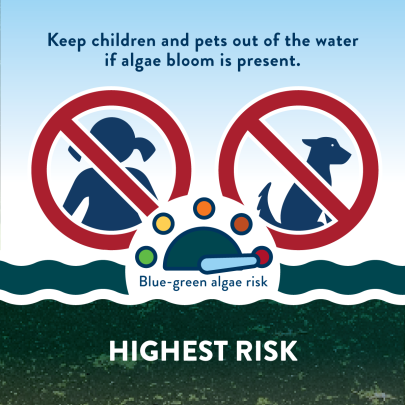
Hot, calm weather creates the perfect conditions for algae growth in Minnesota lakes. Blue-green algae “blooms” have a thick, cloudy appearance that can look like green paint, pea soup, or floating mats of scum. Some, but not all, species of blue-green algae contain potent toxins that can be deadly to dogs, livestock, and other animals within hours of contact. The toxins can also sicken humans.
Blue-green algae blooms can occur anytime during the summer, though they are normally associated with warm weather and low rainfall. Algae are a natural part of the ecosystem, but under certain conditions, algae populations can “bloom” with dramatic growth. Most blue-green algae are not toxic, but there is no way to visually identify whether a particular bloom contains toxins that are harmful to people or animals, and toxins can persist in the water after a bloom. If it looks and smells bad, don’t take a chance. If in doubt, stay out!
People and pets at risk
People can become sick from swallowing or having skin contact with water that has toxic algae, or by breathing tiny droplets of water in the air. In most people, symptoms are mild and may include vomiting, diarrhea, rash, eye irritation, cough, sore throat, and headache. If you come in contact with algae, rinse off with clean water afterwards.

However, dogs are more likely than people to get sick or even die after contact with harmful algae blooms, in part because they are smaller. Dogs are also more willing to wade into lakes with algal scum. They tend to swallow water while swimming, and lick their coats afterwards, ingesting algae. Dogs exposed to blue-green algae can experience symptoms such as vomiting, diarrhea, rash, difficulty breathing, general weakness, liver failure, and seizures. If your dog has symptoms after visiting a lake, seek veterinary care immediately. Several dog deaths in the state have been attributed to toxic algae.
Report any possible human or animal illness to the Minnesota Department of Health's Foodborne and Waterborne Illness Hotline or call 877-366-3455. While algae blooms are a normal part of lake ecology, if you do see a large or dense bloom or one that has caused illness, you can report it to the bloomWatch app.
Preventing toxic algae
Algal blooms develop when lakes contain excessive levels of nutrients such as phosphorus. The best way to prevent them over the long term is to reduce the amount of nutrient runoff into lakes from fertilizers and organic materials like leaves and yard waste. Preventing excess nutrients in lakes and rivers is a long-term goal that will involve changing agricultural practices, properly managing municipal stormwater, applying in-lake treatments, reinforcing shorelines, and much more.
Some cities, counties, or even resorts with popular beaches on lakes that are prone to harmful algae blooms may wish to test for toxic algae during the summer season. The MPCA has guidance and tools to help beach managers choose monitoring strategies and communicate with users about limiting their risk of exposure to harmful algae blooms. Learn more on the Harmful algae blooms: Water recreation advisories page.